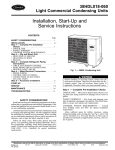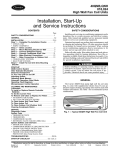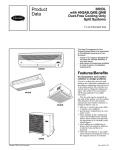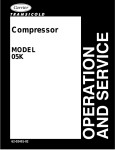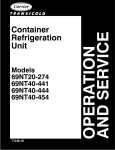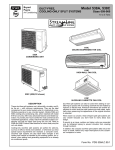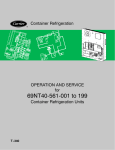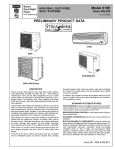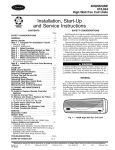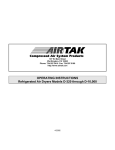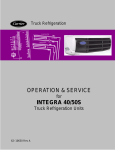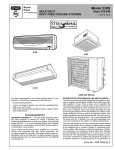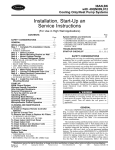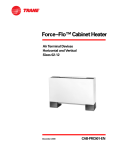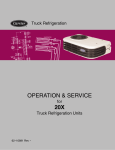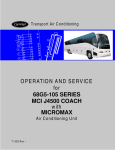Download Installation, Start-Up and Service Instructions - HVAC-Talk
Transcript
38HDS024,048 Outdoor Condensing Unit Installation, Start-Up and Service Instructions CONTENTS Page GENERAL . . . . . . . . . . . . . . . . . . . . . . . . . . . . . . . . . . . 1-3 System Description . . . . . . . . . . . . . . . . . . . . . . . . . . 1 Planning the System . . . . . . . . . . . . . . . . . . . . . . . . . 3 SAFETY CONSIDERATIONS . . . . . . . . . . . . . . . . . . . 3 INSTALLATION . . . . . . . . . . . . . . . . . . . . . . . . . . . . . 3-13 Step1 — Complete Pre-Installation Checks . . . . 3 • UNPACK OUTDOOR UNIT • INSPECT SHIPMENT • CONSIDER SYSTEM REQUIREMENTS Step 2 — Install Outdoor Unit . . . . . . . . . . . . . . . . . 3 • MOUNTING ON GROUND • MOUNTING ON ROOF • SURROUNDING FENCES AND WALLS • RIGGING Step 3 — Install Fan Coil Units . . . . . . . . . . . . . . . 5 Step 4 — Complete Refrigerant Piping Connections . . . . . . . . . . . . . . . . . . . . . . . . . . . . . . 11 • MAKE PIPING SWEAT CONNECTIONS • PROVIDE SAFETY RELIEF • LEAK TEST, EVACUATE, AND DEHYDRATE SYSTEM Step 5 — Make Electrical Connections . . . . . . . 12 • OUTDOOR CONDENSING UNIT • INSTALL BRANCH CIRCUIT DISCONNECT PER NEC • ROUTE LINE POWER LEADS • CONNECT GROUND LEAD AND POWER WIRING • INDOOR UNIT • CONNECT CONTROL CIRCUIT WIRING • RECONFIGURE FOR ONE FAN COIL UNIT PER COMPRESSOR CIRCUIT IF NECESSARY START-UP . . . . . . . . . . . . . . . . . . . . . . . . . . . . . . . . 13-18 Preliminary Checks . . . . . . . . . . . . . . . . . . . . . . . . . 13 Leak Test . . . . . . . . . . . . . . . . . . . . . . . . . . . . . . . . . . . 13 Evacuate and Dehydrate . . . . . . . . . . . . . . . . . . . . . 13 Charge System . . . . . . . . . . . . . . . . . . . . . . . . . . . . . 13 Unit Operation . . . . . . . . . . . . . . . . . . . . . . . . . . . . . . 17 • FAN COIL UNITS • 38HDS OUTDOOR CONDENSING UNIT • 38HDS MICROPROCESSOR CONTROL OF OUTDOOR FAN • STATUS INDICATOR LIGHTS • UNIT MALFUNCTION SERVICE . . . . . . . . . . . . . . . . . . . . . . . . . . . . . . . . . . 18-21 Outdoor Fan . . . . . . . . . . . . . . . . . . . . . . . . . . . . . . . . 18 Scroll Compressors . . . . . . . . . . . . . . . . . . . . . . . . . 19 • TIME-DELAY DEVICE OVERRIDE • SYSTEM STATUS LEDs AND FAULT CODES High-Pressure Relief Valve . . . . . . . . . . . . . . . . . . 19 Internal Current and Temperature Sensitive Overload . . . . . . . . . . . . . . . . . . . . . . . . 19 High-Pressure Switch . . . . . . . . . . . . . . . . . . . . . . . 19 Low-Pressure Switch . . . . . . . . . . . . . . . . . . . . . . . . 19 Service Valves . . . . . . . . . . . . . . . . . . . . . . . . . . . . . . 20 Refrigerant Charging . . . . . . . . . . . . . . . . . . . . . . . . 20 • SUBCOOLING CHARGING METHOD Compressor Lockout Switch (CLO) . . . . . . . . . . 20 Indoor Coil Temperature Sensor . . . . . . . . . . . . . 20 Low-Ambient Control Thermistor (LAT) . . . . . . . 20 Pressure Transducer . . . . . . . . . . . . . . . . . . . . . . . . 21 MAINTENANCE . . . . . . . . . . . . . . . . . . . . . . . . . . . . . 21 Lubrication . . . . . . . . . . . . . . . . . . . . . . . . . . . . . . . . . 21 • FAN-MOTOR BEARINGS • COMPRESSOR Cleaning Coils . . . . . . . . . . . . . . . . . . . . . . . . . . . . . . 21 TROUBLESHOOTING . . . . . . . . . . . . . . . . . . . . . . . . 22 Checking Cooling Control Operation . . . . . . . . . 22 START-UP CHECKLIST . . . . . . . . . . . . . . . . CL-1-CL-4 GENERAL IMPORTANT: Before installing a multi-split system, carefully read the following information: • The TXV (thermostatic expansion valve) is located in the outdoor unit, NOT the indoor fan coil units. • The 38HDS outdoor unit has a factory-installed lowambient control. • BOTH refrigerant lines between the indoor and outdoor units MUST BE insulated, because the TXV is in the outdoor unit. • DO NOT install a filter drier in the line set to the fan coil units. A filter drier has already been factory-installed on the outdoor unit. • The 38HDS unit has been pre-charged at the factory with sufficient refrigerant for the entire system (assuming 50 ft of tubing and the use of one of the system combinations listed in Planning the System section on page 3). System Description — The 38HDS multi-split air conditioning system requires 3 major components (see Fig. 1): • A 38HDS outdoor condensing unit • Either 2, 3, or 4 duct-free split fan coil units for distribution of air to a maximum of 4 independent zones (see Planning the System section on page 3) • A wireless infrared remote controller to control each fan coil unit independently (one remote controller is necessary for each fan coil unit) NOTE: The wireless infrared remote controller is not available for 40QKB in-ceiling cassette fan coil units. IMPORTANT: The 38HDS outdoor units may only be used with the indoor fan coil unit sizes listed in Planning the System section on page 3. DO NOT try to substitute or add more fan coils to these systems. Manufacturer reserves the right to discontinue, or change at any time, specifications or designs without notice and without incurring obligations. Book 1 4 PC 111 Catalog No. 533-826 Printed in U.S.A. Form 38HDS-2SI Pg 1 8-97 Replaces: 38HDS-1SI Tab 3e 2f 40QNB HIGH-WALL FAN COIL UNIT 40QKB IN-CEILING CASSETTE FAN COIL UNIT 40QAB CEILING-SUSPENDED FAN COIL UNIT 38HDS OUTDOOR CONDENSING UNIT (048 Unit Shown) Fig. 1 — Multi-Split System Components 2 Planning the System — This is a complex system with up to 4 separate tubing systems and 8 different control cable sets. Plan the installation carefully as instructed below. Read these installation instructions (outdoor condensing unit) and the installation instructions included with the fan coil units carefully and completely PRIOR to system installation. 1. Maximum line length is 50 ft equivalent (any single line run), and maximum elevation differential is 30 ft (from highest to lowest system component). 2. Verify that Carrier components received form a legitimate multi-split system as follows: a. Systems using one 38HDS024 outdoor condensing unit may use any combination (for a total of 2) of Carrier nominal 11⁄2 ton fan coil units and require 2 circuits per compressor. b. Systems using one 38HDS048 outdoor condensing unit may use any of the following combinations: • any combination (for a total of 2) of Carrier nominal 2 ton fan coil units (1 fan coil unit per compressor). • any one Carrier nominal 2-ton fan coil unit on one circuit, and any combination of 2 Carrier nominal 11⁄2 ton fan coil units (for a system total of 3) on the other compressor. • any combination (for a total of 4) of Carrier nominal 11⁄2 ton fan coil units (2 fan coil units per circuit and 2 circuits per compressor). 3. Identify and record each fan coil section as it will be connected to the 38HDS outdoor unit on the Multi-Split Installation Planning Worksheet included as part of the Start-Up Checklist on page CL-1. 4. Check all system components to ensure that all required materials are on hand before starting installation of this system. 5. Re-read Step 3 — Install Fan Coil Units section on page 5 before installing indoor fan coil units. INSTALLATION Step 1 — Complete Pre-Installation Checks UNPACK OUTDOOR UNIT (see Fig. 1) — Move 38HDS unit to final location. Remove carton from unit, being careful not to damage service valves and grilles. INSPECT SHIPMENT — File claim with shipping company if shipment is damaged or incomplete. Check unit nameplate to be sure unit matches job requirements. CONSIDER SYSTEM REQUIREMENTS — Consult local building codes and NEC for special installation requirements. Allow sufficient space for airflow, wiring, refrigerant piping, and servicing unit. See Fig. 2 and 3. Locate unit so that condenser coil airflow is unrestricted on both sides. Refer to Fig. 2 and 3. Unit may be mounted on a level pad directly on base legs or mounted on raised pads at support points. See Fig. 2 and 4 for center of gravity. Step 2 — Install Outdoor Unit MOUNTING ON GROUND — Mount unit on a solid, level concrete pad. Position unit so water or ice from roof does not fall directly onto unit. If conditions or local codes require unit be fastened to pad, 6 field-supplied tiedown bolts should be used and fastened through slots provided in unit mounting feet. See Fig. 2. MOUNTING ON ROOF — Mount unit on a level platform or frame at least 6 in. (154 mm) above roof surface. Isolate unit and tubing from structure. SURROUNDING FENCES AND WALLS — Select and install surrounding fences and walls to allow for free entry of ambient air. Avoid pits and solid walls as unit surroundings, because recirculation of warm discharge air can occur. RIGGING SAFETY CONSIDERATIONS Installing and servicing air-conditioning equipment can be hazardous due to system pressure and electrical components. Only trained and qualified service personnel should install or service air-conditioning equipment. Untrained personnel can perform basic maintenance, such as cleaning and replacing filters. All other operations should be performed by trained service personnel. When working on air-conditioning equipment, observe safety precautions in literature, and tags and labels attached to unit. Follow all safety codes. Wear safety glasses and work gloves. Use quenching cloth for brazing operations. Have fire extinguisher available. Read these instructions thoroughly. Consult local building codes and National Electrical Code (NEC) Standard ANSI/NFPA 70 (American National Standards Institute/National Fire Protection Association) for special installation requirements. Be sure unit panels are securely in place prior to rigging. Keep unit upright. Lift unit using sling. Use cardboard or padding under sling, and use spreader bars to prevent sling damage to unit. See Fig. 4. See Fig. 2 for center of gravity reference. Install unit so that coil does not face into prevailing winds. If this is not possible and constant winds above 25 mph are expected, field fabricate and install wind baffles. In areas where outdoor ambient will be less than 40 F during cooling, wind baffles are also required. See Fig. 5. Before installing or servicing system, always turn off main power to system. There may be more than one disconnect switch, since each fan coil unit will normally have its own disconnect. Turn off accessory heater power if applicable. Electrical shock can cause personal injury. 3 UNIT 38HDS 024 048 UNIT 38HDS 024 048 UNIT 38HDS 024 048 A Ft-in. 2-11⁄8 3-13⁄16 B mm 638 945 Ft-in. 3-015⁄16 3-89⁄16 J Ft-in. 1-27⁄16 1-23⁄4 C mm 938 1132 Ft-in. 1-29⁄16 1-51⁄16 K mm 367 375 Ft-in. 0-63⁄4 0-71⁄2 D mm 370 433 L mm 171 191 Ft-in. 1-0 1-6 Ft-in. 1-4 1-67⁄16 M mm 305 457 Ft-in. 0-05⁄8 0-05⁄8 E Ft-in. 1-117⁄16 2-61⁄2 mm 406 468 F mm 595 775 N mm 16 16 Ft-in. 0-03⁄8 0-03⁄8 MINIMUM MOUNTING PAD DIMENSIONS SUPPORT FEET SNOW STAND ICE STAND Ft-in. mm Ft-in. mm Ft-in. mm 1-11 x 3-6 584 x 1067 2-2 x 3-6 660 x 1067 2-2 x 3-6 660 x 1067 2-0 x 4-2 610 x 1270 2-4 x 4-4 711 x 1270 2-2 x 4-2 660 x 1270 G mm 437 499 R mm 10 10 Ft-in. — 0-65⁄16 Ft-in. 1-51⁄2 2-55⁄8 S mm — 160 Ft-in. — 0-57⁄8 mm — 149 H mm 445 753 Ft-in. 1-81⁄8 2-83⁄16 mm 511 818 OPERATING WEIGHT Lb Kg 159 72.0 292 132.3 NOTES: 1. Required clearances: with coil facing wall; allow 6 in. minimum clearance on coil side and coil end, and 3 ft minimum clearance on compressor end and fan side. With fan facing wall; allow 8 in. minimum clearance on fan side and coil end, and 3 ft minimum clearance on compressor end and coil side. With multi-unit application: arrange units so discharge of one does not enter inlet of another. 2. Dimensions in [ ] are in millimeters. 3. Center of gravity . Fig. 2 — Base Unit Dimensions 4 Ft-in. 1-53⁄16 1-75⁄8 NOTE: Dimensions in [ ] are in mm. (A) Minimum operating clearance required when this side faces a wall. (B) Minimum operating clearance required when this side faces away from a wall. Fig. 3 — Operating and Service Clearance Step 3 — Install Fan Coil Units — Refer to Installation, Start-Up and Service Instructions provided with the fan coil units. NOTE: If this system is mixing 2 or more types of fan coil units, be sure to follow instructions provided with each type of fan coil unit closely. Mount fan coil units in locations which will be easily accessible when routing refrigerant tubing (see Fig. 6-9) and electrical wiring between the fan coil units and outdoor unit. Fan coil unit locations must also provide adequate drainage capabilities. If desired, condensate pumps may be used with any type of fan coil unit. IMPORTANT: DO NOT install filter driers or AccuRatert refrigerant metering device body or pistons into this system. Thermostatic expansion valves are located in the outdoor condensing unit to control refrigerant flow. Fig. 4 — Lifting Unit With Sling 5 6.1 (154) 0.4 (9) 0.4 (9) 6.1 (156) CROSS BREAK 5.7 (144) 45° CROSS BREAK 5.7 (144) 0.2 (5) 45° 9.8 (250) 9.7 (247) 12.4 (314) 16.0 (406.4) 15.7 (400.0) 10 (254) 0.2 (5) 32 (812.8) 22.0 (560) 19.4 (494) 34.0 (866) 31.4 (800) 20 (508) 1.3 (33) 1.3 (33) 1.3 (33) END END 0.4 (9) 0.4 (9) 5.9 (151) 5.7 (145.5) 5.7 (145.5) CROSS BREAK 0.2 (5) 5.9 (151) 26.6 (666) 0.2 (5) CROSS BREAK 36.9 (938) 45° 15.7 (400) 9.7 (247) 34.0 (866) 22.0 (560) 22.0 (558.8) 19.4 (494) 3.14 (800.0) 10.0 (254) 3.4 (86) 3.4 (86) 1.3 (33) FRONT FRONT 38HDS024 NOTE: Dimensions in ( 1.3 (33) 38HDS048 ) are millimeters. Fig. 5 — Wind Baffle Dimensions 6 7 LEGEND M — Motor SV — Solenoid Valve TXV — Thermostatic Expansion Valve Field-Supplied Tubing NOTE: Insulate ALL lines between outdoor condensing unit and indoor fan coil units. Fig. 6 — Refrigerant Tubing Schematic (38HDS048 Shown) LEGEND NEC — National Electrical Code Piping Line Voltage 24 V *Standard. †Field supplied. NOTES: 1. All piping must follow standard refrigerant piping techniques. Refer to Carrier System Design Manual. 2. All wiring must comply with the applicable local and national codes. 3. Wiring and piping shown are general points-of-connection guides only and are not intended for a specific installation. 4. Insulate condensate drain if installed in a conditioned space. 5. Vapor supply line and suction line must be insulated. 6. Do not install filter drier. 7. Do not install AccuraterT Metering Device. Fig. 7 — Typical Piping and Wiring, High Wall Systems 8 LEGEND f — Phase NEC — National Electrical Code Piping Line Voltage 24 V *Standard. †Accessory item. **Field supplied. NOTES: 1. All piping must follow standard refrigerant piping techniques. Refer to Carrier System Design Manual. 2. All wiring must comply with the applicable local and national codes. 3. Thermostat is required. 4. Wiring and piping shown are general points-of-connection guides only and are not intended for a specific installation. 5. Insulate condensate line if run above a conditioned space. 6. Do not install AccuRaterT metering device. 7. Do not install filter drier. 8. Vapor supply and suction lines must be insulated. Fig. 8 — Typical Piping and Wiring, Ceiling-Suspended Systems 9 LEGEND f — Phase NEC — National Electrical Code Piping Line Voltage 24 V *Standard. †Accessory item. **Field supplied. NOTES: 1. All piping must follow standard refrigerant piping techniques. Refer to Carrier System Design Manual. 2. All wiring must comply with the applicable local and national codes. 3. Thermostat is required. 4. Wiring and piping shown are general points-of-connection guides only, and are not intended for a specific installation. 5. Insulate condensate line if run above a conditioned space. 6. Do not install AccuRaterT metering device. 7. Do not install filter drier. 8. Vapor supply and suction lines must be insulated. Fig. 9 — Typical Piping and Wiring, In-Ceiling Cassette Systems 10 Table 1 — Physical Data Step 4 — Complete Refrigerant Piping NOTE: Complete all refrigerant tubing connections at the fan coil units first. Then route the tubing sets back to the outdoor unit. Mark each tubing set carefully to identify its respective fan coil unit. Outdoor units may be connected to indoor units using fieldsupplied tubing of refrigerant grade and condition. See Table 1 for correct line sizes. Do not use less than 10 ft (3 m) of interconnecting tubing. NOTE: It is not necessary to make any changes to line sizes or any refrigerant system modifications when using recommended refrigerant line lengths. When installing tubing both the vapor return line and the vapor supply (smaller) line must be insulated between outdoor unit and indoor unit to avoid condensation on the lines. Use closed-cell foam insulation and tape all seams and joints. Unit 38HDS Nominal Capacity (Btuh) Operating Weight (lb) Refrigerant Quantity (lb) Circuit A Circuit B Compressor Type Model Oil (oz) — (Recharge) Crankcase Heater Watts Outdoor Fan Rpm Diameter (in.)...No. of Blades Fan Pitch (Deg) Motor Hp Nominal Airflow (cfm) Outdoor Coil DO NOT BURY MORE THAN 36 IN. (922 mm) OF REFRIGERANT TUBING IN THE GROUND. If any section of tubing is buried, there must be a 6-in. (154 mm) vertical rise to the valve connections on the outdoor unit. If more than the recommended length is buried, refrigerant may migrate to cooler, buried section during extended periods of system shutdown. This causes refrigerant slugging and could possibly damage compressor at start-up. DO NOT USE MORE THAN 50 FT of equivalent interconnecting tubing or more than 30 ft of vertical lift (see Fig. 10) between the lowest system component and the highest system component. Face Area (sq ft)...No. of Rows Fins/in. Line Sizes* Vapor Return Quantity...OD (in.) Vapor Supply Quantity...OD (in.) Valve Connection — ODF (in.) Vapor Return Quantity...ODF (in.) Vapor Supply Quantity...ODF (in.) Controls High-Pressure Switch Cutout (psig) High-Pressure Switch Cut-in (psig) Low-Pressure Switch Cutout (psig) Low-Pressure Switch Cut-in (psig) Discharge Temperature Switch Cutout† (F) Fusible Plug When more than 50 ft of interconnecting tubing or more than 30 ft of vertical lift is necessary, contact your local distributor. If either refrigerant tubing or indoor coil is exposed to atmospheric conditions for longer than 5 minutes, it must be evacuated to 1000 microns to eliminate contamination and moisture in the system. Run refrigerant tubes as directly as possible, avoiding unnecessary turns and bends. Suspend refrigerant tubes so they do not damage insulation on vapor return tube and do not transmit vibration to structure. Also, when passing refrigerant tubes through wall, seal opening so that vibration is not transmitted to structure. Leave some slack in refrigerant tubes between structure and outdoor unit to absorb vibration. See Fig. 6 for indoor to outdoor unit tubing connections, and refer to separate indoor fan coil unit installation instructions for additional information. NOTE: If only 2 fan coil units are used on 38HDS048 systems, be sure that one is used with each compressor refrigerant circuit. If 2 or 3 fan coils are used, cap any unused refrigerant lines at the service valves. 024 24,000 159 048 48,000 292 R-22 5.0 — 5.5 5.5 Hermetic Scroll Copeland Copeland ZR23K1-PFV ZR23K1-PFV 25 25 19 27 Propeller Type, Direct-Drive, Horizontal 850 850 18...3 24...3 27 24 1⁄8 1 ⁄4 1720 3900 Copper Tube, Aluminum-Plate Fin 6.1...2 12.3...2 15 15 2...5⁄8 2...3⁄8 4...5⁄8 4...3⁄8 2...5⁄8 2...3⁄8 4...5⁄8 4...3⁄8 426 320 7 22 6 6 6 6 7 20 3 5 280 210 F *Line sizes are for runs up to 25 ft. †Switch will reset automatically when temperature drops below 280 F. MAKE PIPING SWEAT CONNECTIONS — Check tubing set identification against Multi-Split Installation Planning Worksheet on page CL-1 to ensure correct selection of service valve set on outdoor unit. To avoid damage while brazing, service valves should be wrapped with a heat-sinking material such as a wet cloth. When brazing tubing sets to the service valves, a brazing shield MUST be used to prevent damage to the painted unit surface. Remove plastic caps from liquid and suction service valves. Use refrigerant grade tubing. Service valves are closed from the factory and are ready for brazing. Pass nitrogen or other inert gas through piping while brazing to prevent formation of copper oxide. After wrapping the service valve with a wet cloth, the tubing set can be brazed to the service valve using either silver bearing or non-silver bearing brazing material. Consult local code requirements. Refrigerant tubing and indoor coil are now ready for leak testing. NOTE: Unit is shipped from the factory with a full system charge of R-22 (exact amount is indicated on unit nameplate). DO NOT INSTALL A FIELD-SUPPLIED FILTER DRIER in this system. Filter drier is factory installed inside the outdoor unit. Installing a filter drier in the liquid line between the indoor and outdoor units will cause a high-pressure drop, and will result in abnormal system operation. 11 *The maximum system elevation is 30 ft from lowest point in the system to highest point in the system. Fig. 10 — Maximum Elevation Differential PROVIDE SAFETY RELIEF — A fusible plug is located in unit suction line; do not cap this plug. If local code requires additional safety devices, install as directed. LEAK TEST, EVACUATE, AND DEHYDRATE SYSTEM — Refer to Leak Test section and Evacuate and Dehydrate section on page 13 for details. OUTDOOR CONDENSING UNIT — Be sure field wiring complies with local and national fire, safety, and electrical codes, and that voltage to the system is within limits shown in Table 2. Contact local power company for correction of improper line voltage. See Table 2 for recommended fuse sizes. When making electrical connections, provide clearance at unit for refrigerant piping connections. INSTALL BRANCH CIRCUIT DISCONNECT PER NEC — Install a disconnect of adequate size to handle unit starting current. Locate disconnect within sight from and readily accessible from unit per Section 440-14 of NEC. ROUTE LINE POWER LEADS — Extend leads from disconnect through power wiring hole provided and into unit splice area. Remove outdoor unit control box cover to gain access to unit wiring. NOTE: Power leads from disconnect into outdoor unit must be COPPER WIRE ONLY. CONNECT GROUND LEAD AND POWER WIRING — Connect ground lead to equipment ground connection in outdoor unit control box. Then connect power wiring to TB1 (terminal block no. 1). See Fig. 11. Splice the line power leads to yellow and black leads provided. INDOOR UNIT — Refer to installation instructions included with the fan coil units for fan coil unit installation and power supply piping. Step 5 — Make Electrical Connections Unit cabinet must have an uninterrupted, unbroken electrical ground to minimize the possibility of personal injury if an electrical fault should occur. This ground may consist of electrical wire connected to unit ground lug in control compartment, or conduit approved for electrical ground when installed in accordance with NEC, ANSI/NFPA 70, and local electrical codes. Failure to follow this warning could result in the installer being liable for personal injury of others. Unit failure as a result of operation on improper line voltage or excessive phase imbalance constitutes abuse and may cause damage to electrical components. Do not install units in system where voltage may fluctuate above or below permissible limits. Such operation would invalidate any applicable Carrier warranty. 12 CONNECT CONTROL CIRCUIT WIRING START-UP Preliminary Checks — Complete Start-Up Checklist on page CL-1 and the following checks prior to starting up unit. 1. Check condensate drainage system. To do this, add a small amount of water into each fan coil unit condensate pan, and ensure that each pan drains freely. Inspect drain pans and lines, and inspect as required. 2. Make sure that all wiring connections are correct and tight. 3. Check all barriers, covers, and panels to ensure they are in place. 4. Identify which fan coil unit valve sets have been connected. To avoid personal injury, be sure system main power switch is turned off before proceeding. 1. Refer to Multi-Split Installation Planning Worksheet completed prior to the start of this installation and verify the markings on each set of control wiring cable sets. 2. Route 24-v control wiring through wiring hole on the outdoor unit. See Fig. 12 for typical connections for each type of fan coil. See. Fig. 13 and 14 for 38HDS component arrangement and unit wiring details. See Fig. 15 for 38HDS control board detail. 3. Connect wiring to screw connections labeled FC1, FC2, FC3, and FC4 on terminal board for each corresponding fan coil unit. See Fig. 12-15. 4. Route the other end of the control wiring back to the fan coil unit and connect to the fan coil terminal board according to the wiring schematic for the fan coil unit. See fan coil unit installation instructions for wiring schematic. LEGEND NEC — National Electrical Code TB1 — Terminal Board TB Connections IMPORTANT: DO NOT open valves which do not have fan coil units connected to them. 5. Unit is shipped with the valve stems frontseated and caps factory installed. Remove caps from all valves to which fan coil units have been connected. Replace caps and tighten until finger tight. 6. Fully backseat (open) the vapor supply and vapor return tube service valves. 7. Turn on main disconnect switch(es) to indoor fan coil units and outdoor condensing unit. 8. Using the remote controller or thermostat for each indoor fan coil unit, turn on each fan coil unit and operate each unit in each mode (i.e., electric heat [if provided], and fan cooling) for 15 minutes to test for proper operation. 9. Test for proper refrigerant charge in each circuit using the subcooling method. Leak Test — Field piping and all tubing connections must be leak tested by the pressure method described in the Carrier General Training for Air Conditioning Manual (GTAC2), Module 5. Use R-22 at approximately 25 psig backed up with an inert gas to reach a total system pressure not to exceed 245 psig. Field Wiring Factory Wiring Fig. 11 — Line Power Connections RECONFIGURE FOR ONE FAN COIL UNIT PER COMPRESSOR CIRCUIT IF NECESSARY — The control also provides the option of using either 1 or 2 fan coil units per compressor (depending on the position of the jumpers on J3 and J4 on the control board). See Fig. 15. The control is preset to 2 fan coil units per compressor at the factory. If only one fan coil per compressor is to be used, position a jumper between pins 1 and 2 on J3 and J4 (one jumper for each set of pins). Jumper J3 is associated with the compressor on the 38HDS024 units and compressor number 1 on 38HDS048 units (bottom compressor). Jumper J4 is associated with compressor number 2 on the 38HDS048 units. Evacuate and Dehydrate — Field piping and fan coil must be evacuated and dehydrated by either of the methods described in GTAC2, Module 5. Service valves must be fully backseated to close service port. There is no Schrader valve at the service port, and failure to backseat the valve could result in loss of system charge or personal injury. Charge System — Release charge into system by opening (backseating) vapor supply and vapor return line service valves. Open ONLY those service valve sets which have fan coil unit sections connected to them. DO NOT open valves where no field tubing has been connected. 13 LEGEND FC — Fan Coil Unit TB — Terminal Block Fig. 12 — Control Line Connections (Typical Connections for Each Type of Fan Coil Illustrated) 14 Fig. 13 — Component Arrangement, 38HDS024 Fig. 14 — Component Arrangement, 38HDS048 LEGEND FOR FIG. 13 AND 14 C CAP CLO COMP CT DTS — — — — — — Contactor, Compressor Capacitor Compressor Lock Out Compressor Motor Current Transformer Discharge Temperature Switch EQUIP — Equipment FC — Fan Coil Unit FCR — Fan Coil Relay FR GND HPS LPS LA MCB NEC OFM SV TB — — — — — — — — — — Fan Relay Ground High-Pressure Switch Low-Pressure Switch Low Ambient Multi-Split Control Board National Electrical Code Outdoor-Fan Motor Solenoid Valve Terminal Block TH — Themistor TR — Transducer TRAN — Transformer Terminal (Field) Terminal (Marked) Terminal (Unmarked) 15 Terminal Block Splice Factory Wiring Field Power Wiring LEGEND C — Compressor FC — Fan Coil J, P — Connectors LED — Light-Emitting Diode SW — Switch *Circuit No. 1 Option. †Circuit No. 2 Option. Fig. 15 — Outdoor Unit Microprocessor Control Board 16 Table 2 — Electrical Data OPERATIONAL VOLTAGE* UNIT 38HDS V-PH-Hz 024 048 208/230-1-60 COMPRESSOR FAN Min Max Quantity RLA LRA FLA MCA 187 254 1 2 12.9 62.5 0.70 1.45 16.8 30.5 LEGEND POWER SUPPLY Max Fuse or HACR-Type Circuit Breaker Amps 25 40 2. All motors and compressors contain internal overload protection. 3. In compliance with NEC requirements for multimotor and combination load equipment (refer to NEC Articles 430 and 440), the overcurrent protective device for the unit shall be fuse or HACR breaker. 4. Motor RLA values are established in accordance with UL (Underwriters’ Laboratories) Standard 1995. FLA — Full Load Amps HACR — Heating, Air Conditioning, Refrigeration LRA — Locked Rotor Amps MCA — Minimum Circuit Amps per NEC Section 430-24 NEC — National Electrical Code RLA — Rated Load Amps (Compressor) *Permissible limits of the voltage range at which unit will operate satisfactorily. NOTES: 1. The 38HDS units contain a 24-v transformer; additional transformers are not required. The head pressure for the 2 compressors will be monitored to control the outdoor fan output. The control reads an outdoor temperature thermistor to determine if the head pressure should be used to control the fan output. There are 3 jumpers and one slide switch used to determine if the head pressure should be used to control the fan output. See 38HDS MICROPROCESSOR CONTROL OF OUTDOOR FAN section on next page for more details. The 38HDS unit control also includes an integral head pressure control function. This function will maintain a minimum head pressure by cycling the outdoor fan motor in response to inputs from the thermistor (for outdoor ambient temperature) and the transducers (for system discharge pressures in each compressor circuit). Operation — The 38HDS unit receives a 24-v control signal from each fan coil unit as each fan coil unit initiates a demand for cooling. The 24-v signal energizes a control relay in the 38HDS unit (one relay per fan coil unit). The refrigerant flow to each fan coil unit is controlled through a solenoid valve (one valve per fan coil unit). The solenoid valve(s) will not open until compressor operation is initiated by the controller. The microprocessor control in the 38HDS unit includes a 2-minute, anti-short cycle, time-delay function. This function provides a minimum off delay between compressor run stages (2 minutes each from the end of the last on period to the beginning of the next on period). If more than 2 minutes have passed since the end of the last on period, the compressor will be ready to restart with initiation of demand from any fan coil unit on its circuit. Unit Operation NOTE: AUTO. fan mode is used as the unit operation example for ALL fan coil units in this section. Contact your local Carrier dealer for operation information in other fan modes. FAN COIL UNITS — Each fan coil unit has a self-contained control system that determines the set point for fan coil operation, fan mode operation, and heating mode operation (if provided). The fan coil units are equipped with either a wired or wireless remote controller set (wireless remote controller is not available for 40QKB or 40QAB fan coil units). Set points and fan modes may be determined separately for each fan coil unit. Each fan coil unit may call for cooling operation independently. On a call for cooling operation by a single fan coil unit, a 24-v signal is sent to the 38HDS outdoor unit and energizes a control relay. The indoor blower starts according to the normal fan coil unit sequence of operation. The control relay (in the outdoor unit) initiates operation of a cooling cycle for the respective indoor unit refrigerant circuit; including opening a liquid line solenoid valve in the outdoor unit. As the set point at each fan coil is satisfied, its individual 24-v signal to the 38HDS unit stops, and the respective solenoid valve for each fan coil unit closes. The indoor fan cycles off. 38HDS OUTDOOR CONDENSING UNIT — The outdoor unit is equipped with a control that will monitor the indoor fan coil unit cooling request. The control will turn on solenoid valves for the appropriate indoor fan coil unit system. The control will also combine the cooling requests to control up to 2 compressors. 17 Increased Demand for Cooling NOTE: There are 2 separate compressor circuits in the 38HDS048 units (circuit A and circuit B). Each circuit operates independently, and will operate as follows (as will the single-circuit 024 units) upon receiving the first 24-v cooling demand signal from a fan coil unit: 1. After the 2-minute time-delay function is satisfied, the appropriate compressor starts. 2. The solenoid valve connected to the fan coil sending the demand signal is energized (at the 38HDS units). 3. The outdoor fan starts, and its operation is controlled by the microprocessor as described in 38HDS Microprocessor Control of Outdoor Fan section below. When a second fan coil unit signals a demand for cooling, its associated solenoid valve is energized immediately, allowing refrigerant to flow to both fan coil units simultaneously. Decreased Demand for Cooling — When a fan coil unit’s demand for cooling ends, the 24-v signal to the 38HDS unit stops, and the appropriate solenoid valve closes. If the other fan coil unit on this circuit still has a demand, the appropriate compressor will continue to run as long as necessary for the second fan coil unit. When the second fan coil unit’s demand for cooling ends, its solenoid valve closes, and the appropriate compressor stops. The compressor will not start for at least 2 minutes after the end of this cycle due to the time-delay function. On size 024 units, when the compressor stops, the outdoor fan also stops. On size 048 units, outdoor fan operation may continue under control of the 38HDS microprocessor if the other refrigerant circuit is still operating. The outdoor fan will only stop when both compressors are off. Refer to 38HDS Microprocessor Control of Outdoor Fan section below for more details. 38HDS MICROPROCESSOR CONTROL OF OUTDOOR FAN — The microprocessor control has a built-in head pressure control system that will cycle the outdoor-fan motor to maintain a selected discharge pressure. The microprocessor senses outdoor ambient temperature using a thermistor and refrigerant pressure using a pressure transducer mounted on the compressor circuit discharge line. The 38HDS024 units have one transducer, and the 048 units have two. The factory set points for the head pressure control operation are 55 F for outdoor ambient temperature and 250 psig for discharge pressure. The current set points can be determined as follows (see Fig. 15): If pin numbers 2 and 3 on J1 are jumpered, the setting is 250 psig (factory setting); if pin numbers 1 and 2 are jumpered, the setting is 200 psig. When switch SW1 is set at the top setting, ambient set point is 55 F. When the switch is set to the bottom setting, ambient set point is 35 F. When the outdoor ambient temperature is above the outdoor ambient set point and both fan coils on a compressor circuit are calling for cooling operation, the outdoor fan will run at full speed whenever compressor operation is permitted. When only one fan coil is calling for cooling, fan cycling is permitted at all ambient temperatures. Fan motor will be cycled on and off to maintain set point discharge pressure. When the outdoor ambient temperature is below the specified set point, the fan motor will be cycled on and off to maintain a compressor discharge pressure at the specified pressure set point. On 38HDS048 units with 2 compressors running, the compressor with the lower head pressure will control the fan operation. If only one compressor is running, that compressor will control the fan operation. If the discharge pressure on either circuit exceeds 370 psig, the outdoor fan motor will run continuously, and the fan cycling function will be bypassed until the discharge pressure decreases to 365 psig. STATUS INDICATOR LIGHTS (See Table 3 and Fig. 15) — The 38HDS control board is equipped with LED (lightemitting diode) indicators to aid in evaluating the status of the control system, including: • time delay function status • fan coil unit demand status • head pressure control status • current unit malfunctions UNIT MALFUNCTION — Each compressor circuit is equipped with a high-pressure switch (HPS), a low-pressure switch (LPS), and a discharge temperature switch (DTS). These safety devices are located in a Cycle-LOC™ circuit that prevents compressor operation if any of these safety devices is activated. The lockout can be reset by turning the main power to the 38HDS unit off, then on again. Compressor overcurrent protection is achieved by an internal linebreak overload, which will automatically reset when the motor temperature cools to a satisfactory level. Manual reset of Cycle-LOC circuit may also be required. Pressure transducers and the outdoor ambient thermistor are monitored by the 38HDS controller. If a pressure transducer is found to be out of the operating circuit range, the LEDs will flash a code for this fault, but the control will continue to cycle the outdoor fan according to input from the other transducer. If only one transducer is active and is determined to be out of the operating circuit range, the head pressure control will be bypassed and the fan will run continuously. See Table 3 for diagnostic codes. SERVICE Before performing recommended maintenance, be sure unit main power switch is turned off, and be sure all disconnects for indoor fan coil units are open. These systems typically have one disconnect per fan coil unit. Failure to turn off unit main power and open all disconnects may result in electrical shock or injury from rotating fan blade. Outdoor Fan — A reinforced wire mount holds the outdoor fan assembly in position. See Fig. 16 for proper mounting positions. UNIT SIZE — in. (mm) 38HDS024 38HDS048 0.709 (18) 0.16 (4) Fig. 16 — Condenser-Fan Mounting Positions 18 Table 3 — System Status Red and Green LEDs and Fault Codes GREEN LED Number of Number of Flashes On Flashes Off 1 1 2 2 3 3 RED LED Number of Number of Flashes On Flashes Off — Always 1 1 2 2 3 3 1 1 2 2 3 3 1 1 2 2 3 3 UNIT STATUS System Ready Low Head Pressure, Circuit 1 High Head Pressure, Circuit 1 Low Head Pressure, Circuit 2 High Head Pressure, Circuit 2 Low Outdoor Ambient Temperature, Outdoor Thermistor High Outdoor Ambient Temperature, Outdoor Thermistor Hardware Error Time GuardT Device Active, Circuit 1 Time Guard Device Active, Circuit 2 LED — Light-Emitting Diode Scroll Compressors — The 38HDS condensing units use scroll compressors. The 38HDS024 unit has one compressor, and the 38HDS048 unit has 2 compressors which are stacked vertically (using a sheet metal stand to support the top compressor). In the event of a compressor failure, remove and replace the compressor(s) as follows: 1. Attach refrigerant hose to suction service valve of the circuit related to the defective compressor. 2. Recover refrigerant using accepted techniques. 3. Remove discharge and suction piping from compressor by unsweating. Pass either nitrogen or another inert gas through the compressor. 4. Remove compressor mounting bolts. Use a swivel socket to remove the bolt in the rear. 5. Carefully pull compressor stand and piping away from the compressor to remove the compressor. 6. Reverse Steps 1-5 to install the new compressor. High-Pressure Relief Valve — Valve is located in compressor. Relief valve opens at a pressure differential of approximately 450 6 50 psig between suction (low side) and discharge (high side) to allow pressure equalization. Internal Current and Temperature Sensitive Overload — Control resets automatically when internal compressor motor temperature drops to a safe level (overloads may require up to 45 minutes to reset). When an internal overload is suspected of being open, check by using an ohmmeter or continuity tester. If necessary, refer to GTAC2, Module 9, for complete information. High-Pressure Switch — This switch, located on discharge line, protects against high discharge pressures caused by such events as overcharge, condenser-fan motor failure, system restriction, etc. It opens on pressure rise at about 426 psig. If system pressures go above this setting during abnormal conditions, the switch opens. TIME-DELAY DEVICE OVERRIDE — The time delay device can be overridden for easier unit servicing by temporarily shorting the time delay device override connector (P9) located in the control box (see Fig. 15). The short MUST be removed before the time delay device timer can be cleared. DO NOT attempt to simulate these system abnormalities — high pressures pose a serious safety hazard. High-pressure switch is checked with an ohmmeter. If system pressure is below approximately 320 psig switch shows continuity. The high-pressure switch will reset automatically after CLO (compressor lockout switch) has been reset and time-delay device has completed its timing cycle. SYSTEM STATUS LEDs AND FAULT CODES — In normal operating mode, the green LED located on the outdoor unit microprocessor board will flash on and off at a rate of once per second. Whenever a fan coil unit, compressor, or outdoor fan is energized, a red LED designated for each fan coil unit will be illuminated. If there is an error condition, a code will be displayed using the green and red system status LEDs. The green LED will blink its code first, followed by the red LED. The LEDs will flash at a rate of once every 2 seconds, with a 2-second pause between the last red LED flash and the first green LED flash of the next code. See Table 3. Low-Pressure Switch — This switch, mounted on the suction line, has fixed, non-adjustable settings. To check pressure switch, attach pressure gage to suction service valve gage port. Slowly close liquid shutoff valve and allow compressor to pump down. Do not allow compressor to pump down below 2 psig. Compressor should shut down when suction pressure drops to about 7 psig, and should restart when pressure builds up to about 22 psig after CLO has been reset and time-delay device has completed its timing cycle. 19 Table 4 — Required Unit Subcooling Service Valves — The service valves in the outdoor unit are frontseated at the factory. This means the refrigerant charge is isolated from the line-set connection ports. To prevent damage to the valve, use a wet cloth or other accepted heat sink material on the valve before brazing. The service valves must be backseated (turned counterclockwise until seated) before the service port caps are removed and the hoses of gage manifold connected. In this position, refrigerant has access from and through outdoor and indoor unit. The service valve cannot be field repaired; only a complete valve or valve stem seal and service port caps are available for replacement. NOTE: Do not open service valves which are not connected to a tubing set. Be sure any inactive circuits are capped off. SUBCOOLING AT TXV INLET (F) WITH ALL FANS OPERATING 19 16 UNIT 38HDS 024 048 TXV — Thermostatic Expansion Valve Table 5 — Required Liquid Line Temperatures (F) PRESSURE (Psig) AT SERVICE FITTING 134 141 148 156 163 171 179 187 196 205 214 223 233 243 253 264 274 285 297 309 321 331 346 359 Refrigerant Charging To prevent personal injury, wear safety glasses and gloves when handling refrigerant. Do not overcharge system — this can cause compressor flooding. Service valves must be fully backseated to close service port. There is no Schrader valve at the service port, and failure to backseat the valve could result in loss of system charge or personal injury. NOTE: Do not vent or depressurize unit refrigerant to atmosphere. Remove and recover refrigerant following accepted practices (see GTAC2, Module 5). The 38HDS units are factory charged with a full operating charge. Check the system for proper charge level using the subcooling method. If a refrigerant system must be opened for major service work, first recover refrigerant in system as described in GTAC2, Module 5. Evacuate and dehydrate the system when ready to recharge; then weigh in the proper refrigerant quantity (as marked on the unit data plate for each circuit). SUBCOOLING CHARGING METHOD 1. Operate the unit a minimum of 15 minutes before checking the charge. Outdoor fan must be operating continuously when checking subooling. 2. Measure discharge pressure by attaching an accurate gage to the discharge service port. DO NOT use the external service valves for this pressure reading. 3. Measure the vapor supply line temperature by attaching an accurate thermistor-type or electronic thermometer to the vapor supply line near the outdoor coil. See Fig. 17. 4. Refer to Table 4 to find the required subcooling temperature for the unit. Find the point at which the required subcooling temperature intersects the measured internal discharge service port pressure in Table 5. 5. To obtain the required subcooling temperature at a specific discharge pressure, add refrigerant if vapor supply line temperature is higher than indicated, or remove refrigerant if temperature is lower than indicated. Allow a tolerance of ± 3%. REQUIRED SUBCOOLING TEMPERATURE (F) 0 5 10 15 20 25 76 79 82 85 88 91 94 97 100 103 106 109 112 115 118 121 124 127 130 133 136 139 142 145 71 74 77 80 83 86 89 92 95 98 101 104 107 110 113 116 119 122 125 128 131 134 137 140 66 69 72 75 78 81 84 87 90 93 96 99 102 105 108 111 114 117 120 123 126 129 132 135 61 64 67 70 73 76 79 82 85 88 91 94 97 100 103 106 109 112 115 118 121 124 127 130 56 59 62 65 68 71 74 77 80 83 86 89 92 95 98 101 104 107 110 113 116 119 122 125 51 54 57 60 63 66 69 72 75 78 81 84 87 90 93 96 99 102 105 108 111 114 117 120 Compressor Lockout Switch (CLO) — Units are provided with compressor lockout protective device. If the compressor shuts down due to any safety device, a current loop monitoring the compressor current senses no current flow. The unit will lock out until the control power is interrupted to reset the lockout. Determine reason for safety trip. To restart, turn the 38HDS main disconnect to OFF, then to ON position. Indoor-Coil Temperature Thermistor — Thermistor is for use only with duct-free split systems using a microprocessor control (40QN fan coil units only) as part of the system diagnostics. Refer to separate installation instructions for the 40QNB indoor units. Low-Ambient Control Thermistor (LAT) — The low-ambient control thermistor is located on the outdoor fan support bracket. See Unit Operation section on page 17 and Fig. 15 for more information about the controls. 20 Pressure Transducer — The pressure transducer ac- MAINTENANCE tivates the low-ambient control when discharge pressure drops to either 250 psig or 200 psig based on the setting of control jumper J1. See Unit Operation section on page 17 for more information about the controls. If transducer has to be removed for any reason, first disconnect the snap lock plug. The transducer can now be unscrewed and removed without loss of refrigerant since there is a Schrader-type core valve in the transducer port. When reinserting the transducer, reverse this procedure. Be careful not to overtighten the transducer. Before performing recommended maintenance, be sure unit main power switch is turned off. Failure to do so may result in electric shock or injury from rotating fan blade. Lubrication FAN-MOTOR BEARINGS — Oiling holes are provided at each end of condenser-fan motor. Remove fan motor and lubricate motor with 32 drops (16 drops per hole) of SAE-10 (Society of Automotive Engineers) nondetergent oil at the following intervals: • Annually when environment is very dirty, ambient temperature is higher than 105 F (40 C), and average unit operating time exceeds 15 hours a day, or • Every 3 years when environment is reasonably clean, ambient temperature is less than 105 F (40 C), and unit operating time averages 8 to 15 hours a day, or • Every 5 years when environment is clean, ambient temperature is less than 105 F (40 C), and unit operating time averages less than 8 hours a day. COMPRESSOR — Compressor contains factory oil charge; replace oil when lost. See Table 1 for oil recharge and refer to Carrier ‘‘Refrigerant Service Techniques’’ training book for oil recharging procedure. NOTE: Use only Cryol 150A oil in these units. Cleaning Coils — Coil should be washed out with water or blown out with compressed air. Note that the blowthru design causes dirt and debris to build up on the inside of the coils. Clean coil annually or as required by location and outdoor air conditions. Inspect coil monthly and clean as required. Fins are not continuous through coil sections. Dirt and debris may pass through first section, become trapped between the rows of fins, and restrict condenser airflow. Use a flashlight to determine if dirt or debris has collected between coil sections. Clean coil as follows: 1. Turn off unit power. 2. Using a garden hose or other suitable equipment, flush coil from the outside to remove dirt. Be sure to flush all dirt and debris from drain holes in base of unit. Fan motors are waterproof. LEGEND SV — Service Valve X — Measurement Location Fig. 17 — Vapor Supply Line Measurement Locations (38HDS048 Unit Shown) 21 3. At the outdoor unit, check that the LED signal lamp for the indoor fan coil unit is illuminated, that the compressor and the outdoor-fan motor start and run, that the solenoid valve for the indoor fan coil is energized, and that refrigerant is flowing to the correct indoor unit. 4. Observe that cooling operation shuts down when control setting at the fan coil unit is satisfied (compressor stops, outdoor fan stops, solenoid valve closes, and LED for fan coil demand is off). 5. Observe operation of indoor fan during the off period. The fan will be off for 3 minutes, then turn on for 1 minute at low speed (for occupied space air temperature sampling). TROUBLESHOOTING Refer to Figs. 18-23 when troubleshooting these systems. Checking Cooling Control Operation — Check the system for proper control operation as follows (refer to Fig. 23 for more details): 1. Check status LED at the 38HDS control board. A green LED will flash on and off at one-second intervals when the unit is ready to run. If a time delay function is active (3 green LED flashes followed by 2 or 3 red LED flashes), wait 2 minutes for time delay to clear. 2. At a fan coil unit remote controller, select AUTO fan mode, COOL system mode, and adjust set point down until thermometer segment is fully displayed. Notice the snowflake display on the handset (system mode is COOL) and the compressor run display (demand signal is being sent to the outdoor unit). Note that the indoor fan starts at low speed. 22 NOTES: 1. Fan motor is thermally protected. 2. Wire in accordance with National Electrical Code (NEC) and local codes. Replace any original wires with 90° C wire or its equivalent. 3. The CLO locks out the COMP to prevent short cycling on COMP overloads and safety devices. Before replacing CLO check these devices. 4. If indoor section has a transformer with a grounded secondary, connect the grounded side to ‘‘C’’ on the low voltage board. 5. Use minimum 60° C wire for field power wiring. 6. The multi-split control has a 2-minute internal time delay on compressor operation. The pins on plug P9 may be shorted to speed up this time delay for servicing. 7. Jumper J3 must be moved to pins 1-2 when only one fan coil will be used for compressor Circuit 1. Jumper J4 must be moved to pins 1-2 when only one fan coil will be used for compressor Circuit 2. C CAP CLO COMP CT DTS EQUIP FC FCR FR GND HPS LA LPS MCB OFM SV TB TH TR TRAN — — — — — — — — — — — — — — — — — — — — — LEGEND Contactor, Compressor Capacitor Compressor Lockout Compressor Motor Current Transformer Discharge Temperature Switch Equipment Fan Coil Fan Coil Relay Fan Relay Ground High-Pressure Switch Low Ambient Low-Pressure Switch Multi-Split Control Board Outdoor-Fan Motor Solenoid Valve Terminal Block Thermistor Transducer Transformer Terminal (Field) Terminal (Marked) Terminal (Unmarked) Terminal Block Splice Factory Wiring Field Control Wiring Field Power Wiring Fig. 18 — Typical Wiring Schematic; 38HDS024 Condensing Unit 23 LEGEND C CAP CLO COMP CT DTS EQUIP FCR FR GND HPS LA LPS MCB OFM SV TB TH — — — — — — — — — — — — — — — — — — Contactor, Compressor Capacitor Compressor Lockout Compressor Motor Current Transformer Discharge Temperature Switch Equipment Fan Coil Relay Fan Relay Ground High-Pressure Switch Low Ambient Low-Pressure Switch Multi-Split Control Board Outdoor-Fan Motor Solenoid Valve Terminal Block Thermistor TR — Transducer TRAN — Transformer Terminal (Field) Terminal (Marked) Terminal (Unmarked) Terminal Block Splice Factory Wiring Field Control Wiring Field Power Wiring Option or Accessory Wire NOTES: 1. Fan motor is thermally protected. 2. Wire in accordance with National Electrical Code (NEC) and local codes. Replace any original wires with 90° C wire or its equivalent. 3. The CLO locks out the COMP to prevent short cycling on COMP overloads and safety devices. Before replacing CLO check these devices. 4. If indoor section has a transformer with a grounded secondary, connect the grounded side to ‘‘C’’ on the low voltage board. 5. Use minimum 60° C wire for field power wiring. 6. The multisplit control has a 2 minute internal time delay on compressor operation. The PINS on PLUG P9 may be shorted to speed up this time delay for servicing. 7. Jumper J3 must be moved to PINS 1-2 when only one fan coil will be used for compressor Circuit 1. Jumper J4 must be moved to PINS 1-2 when only one fan coil will be used for compressor Circuit 2. Fig. 19 — Typical Wiring Schematic; 38HDS048 Condensing Unit 24 25 LEGEND AGING — For Burn-In Test (short terminals) AS — Assembly C — Contactor CN — Connector COMP — Compressor EMI — Electromagnetic Interference FMC — Fan Motor Capacitor G, GND — Ground HA HS IDC Th IDFM JEM-A L PCB R — — — — — Home Automation Hall-Effect Sensor Indoor-Coil Thermistor Indoor-Fan Motor Japan Electric Manufacturing Industry Association — Left — Printed Circuit Board — Right RA Th RC RCV TB TP TRAN — — — — — — Return-Air Thermistor Resistor Capacitor Receiver Terminal Block Thermal Protector Transformer Terminal (Unmarked) NOTES: 1. If any of the original wire furnished must be replaced, it must be replaced with type 90 C wire or its equivalent. 2. Wire in accordance with National Electrical Code (NEC) and local codes. 3. Fan motor has internal thermal protection. 4. Transformer has an internal 2 amp thermal fuse on the primary side. Fig. 20 — Typical Wiring Schematic; 40QNB High Wall Units Splice Terminal Block Factory Wiring Field Control Wiring Field Power Wiring LEGEND ASM ASR B C CAP CKT CR DR EQUIP GND — — — — — — — — — Air Sweep Motor Air Sweep Relay Board Contactor Capacitor Circuit Control Relay Defrost Relay Equipment Ground FPT — Freeze Protection Thermostat FR — Fan Relay FU — Fuse IFM — Indoor Fan Motor OL — Overload PDR — Pump Delay Relay PL — Plug PM — Pump Motor PSS — Pump Shut-Off Switch RIDTS — Remote Indoor Temperature Sensor TB — Terminal Block TRAN — Transformer Terminal (Marked) Terminal (Unmarked) Splice NOTES: 1. If any of the original wire furnished must be replaced, it must be replaced with type 90° C wire or its equivalent. 2. Wire in accordance with National Electrical Code (NEC) and local codes. 3. Transformer is thermally protected and will reset automatically. 4. IFM(S) has internal thermal protection. Fig. 21 — Typical Wiring Schematic, 40QAB Ceiling-Suspended Units 26 Terminal Block Factory Wiring Field Control Wiring Field Power Wiring Printed Circuit Board Accessory or Optional Wiring LEGEND CAP CR DR EQUIP GND FPT FR — — — — Capacitor Control Relay Defrost Relay Equipment Ground — Freeze Protection Thermostat — Fan Relay IFM OL PDR PL PM PSS RIDTS — — — — — — — Indoor Fan Motor TB — Terminal Block Overload TRAN — Transformer Pump Delay Relay Terminal (Unmarked) Plug Pump Motor Splice Pump Shutoff Switch Terminal Block Remote Indoor Temperature Sensor NOTES: 1. If any of the original wire furnished must be replaced, it must be replaced with type 90° C wire or its equivalent. 2. Wire in accordance with National Electrical Code (NEC) and local codes. 3. Transformer is thermally protected and will reset automatically. 4. IFM(S) has internal thermal protection. Fig. 22 — Typical Wiring Schematic, 40QKB In-Ceiling Cassette Units 27 Factory Wiring Field Control Wiring Field Power Wiring Printed Circuit Board Fig. 23 — Cooling Cycle Troubleshooting Chart Manufacturer reserves the right to discontinue, or change at any time, specifications or designs without notice and without incurring obligations. Book 1 4 PC 111 Catalog No. 533-826 Printed in U.S.A. Form 38HDS-2SI Pg 28 8-97 Replaces: 38HDS-1SI Tab 3e 2f Copyright 1997 Carrier Corporation LEGEND High-Pressure Switch Liquid (Vapor Supply) Line Solenoid Valve Low-Pressure Switch Thermostatic Expansion Valve — — — — HPS LLSV LPS TXV START-UP CHECKLIST A. Multi-Split Installation Planning Worksheet 38HDS024 OUTDOOR CONDENSING UNIT CIRCUIT NO. } 2 } 1 O O O O CIRCUIT IDENTIFICATION FAN COIL FULL MODEL NUMBER INSTALLER’S IDENTIFICATION (Room or Occupied Space Location) FAN COIL FULL MODEL NUMBER INSTALLER’S IDENTIFICATION (Room or Occupied Space Location) 38HDS048 OUTDOOR CONDENSING UNIT CIRCUIT NO. } 4 } 3 } 2 } 1 O O O O O O O O CIRCUIT IDENTIFICATION NOTE: Circuits 1 and 2 are controlled by compressor no. 1, and circuits 3 and 4 are controlled by compressor no. 2. Manufacturer reserves the right to discontinue, or change at any time, specifications or designs without notice and without incurring obligations. Book 1 4 PC 111 Catalog No. 533-826 Printed in U.S.A. Form 38HDS-2SI CL-1 8-97 Replaces: 38HDS-1SI Tab 3e 2f B. Pre-Start-Up OUTDOOR UNIT IS THERE ANY SHIPPING DAMAGE? (Y/N) IF SO, WHERE? WILL THIS DAMAGE PREVENT UNIT START-UP? (Y/N) CHECK POWER SUPPLY. DOES IT AGREE WITH UNIT DATAPLATE? (Y/N) HAS THE GROUND WIRE BEEN CONNECTED? (Y/N) HAS THE CIRCUIT PROTECTION BEEN SIZED AND INSTALLED PROPERLY? (Y/N) ARE THE POWER WIRES TO THE UNIT SIZED AND INSTALLED PROPERLY? (Y/N) ARE ALL TERMINALS TIGHT? (Y/N) Piping ARE REFRIGERANT LINES CONNECTED TO SERVICE VALVE SETS AS INDICATED IN MULTI-SPLIT INSTALLATION PLANNING WORKSHEET? (Y/N) ARE CONTROL POWER LINES CONNECTED TO CONTROL POWER TERMINAL BLOCK AS INDICATED IN MULTISPLIT INSTALLATION PLANNING WORKSHEET? (Y/N) ARE TERMINALS SNUG IN THE HOUSINGS? (Y/N) ARE SERVICE VALVES OPENED AND BACKSEATED? (Y/N) ARE STEM VALVES INSTALLED AND SNUG? (Y/N) HAVE ALL REFRIGERANT CONNECTIONS AND PIPING JOINTS BEEN CHECKED FOR LEAKS? (Y/N) INDOOR FAN COIL UNIT Piping CHECK TO BE SURE ACCURATERt DEVICE IS NOT INSTALLED IN FAN COIL UNIT. CHECK TO BE SURE FILTER DRIER IS NOT INSTALLED IN VAPOR SUPPLY LINE AT INDOOR UNIT. IS VAPOR SUPPLY LINE INSULATED OVER ENTIRE LENGTH TO OUTDOOR UNIT? (Y/N) ARE REFRIGERANT LINES CONNECTED TO SAME SERVICE VALVES AS THE MATCHING CONTROL WIRES? (Y/N) HAVE REFRIGERANT CONNECTIONS BEEN CHECKED FOR LEAKS? (Y/N) IS CONDENSATE LINE CONNECTED? (Y/N) DOES CONDENSATE LINE DRAIN FREELY? (Y/N) IF ACCESSORY CONDENSATE PUMP IS INSTALLED, IS MAXIMUM LIFT OF PUMP LESS THAN 20 INCHES? (Y/N) IF ACCESSORY CONDENSATE PUMP IS INSTALLED, DOES PUMP START AND RUN ACCORDING TO CONTROLS SPECIFICATION? (Y/N) Controls ARE CONTROL POWER WIRES LABELLED ACCORDING TO INDIVIDUAL FAN COIL UNIT? (Y/N) ARE CONTROL WIRES CONNECTED TO THE SAME CIRCUIT AS ASSOCIATED REFRIGERANT LINES? (Y/N) CHECK ROUTING OF LEADS WITHIN SUBBASE; ARE THERE PINCHED OR CUT LEADS? (Y/N) CHECK MOUNTING OF SUBBASE TO WALL; IS IT TIGHT (DO NOT APPLY EXCESSIVE FORCE TO MOUNTING SCREW)? (Y/N) CL-2 B. Pre-Start-Up (cont) Fan System DOES THE FAN ROTATE FREELY? (Y/N) ARE AIR FILTERS IN PLACE? (Y/N) Power Supply DOES THE POWER SUPPLY MATCH THE FAN COIL UNIT DATAPLATE? (Y/N) IS GROUND WIRE CONNECTED? (Y/N) C. Start-Up CHECK INDOOR FAN OPERATION 40QNB Fan Coil Units SELECT FAN MODE, THEN INITIATE TEST SEQUENCE. DOES EACH FAN COIL UNIT START AT LOW SPEED, THEN SHIFT TO MEDIUM SPEED, AND THEN SHIFT TO HIGH SPEED? (Y/N) 40QAB,40QKB Fan Coil Units POSITION SELECTOR SWITCH AT SUBBASE IN EACH FAN SPEED SETTING IN SEQUENCE. DOES EACH FAN COIL UNIT CHANGE SPEEDS PER SWITCH SETTING? (Y/N) START SYSTEM OPERATION AT ONE FAN COIL UNIT SELECT COOLING MODE AND ADJUST SET POINT TO BE BELOW CURRENT ROOM TEMPERATURE. OBSERVE OPERATION OF OUTDOOR CONDENSING UNIT: DOES COMPRESSOR START (AFTER INITIAL TIME DELAY) AND RUN? (Y/N) DOES OUTDOOR FAN RUN OR CYCLE ACCORDING TO SPACE REQUIREMENTS AND OUTDOOR AMBIENT TEMPERATURE? (Y/N) DESELECT COOLING MODE AT INDOOR FAN COIL UNIT. REPEAT FOR REMAINING FAN COIL UNIT(S), AND RECORD ALL INFORMATION BELOW: START SYSTEM OPERATION AT BOTH FAN COIL UNITS ON A SINGLE COMPRESSOR CIRCUIT (FOR 40QAB,QYB FAN COIL UNITS, SELECT COOL MODE AND INITIATE TEST CYCLE) AFTER AT LEAST 15 MINUTES RUNNING TIME, RECORD THE MEASUREMENTS BELOW. FOR SYSTEMS USING 38HDS048 UNITS, REPEAT THIS PROCEDURE FOR THE SECOND COMPRESSOR CIRCUIT. SYSTEM A SYSTEM B COMPRESSOR AMPS (L1/L2) OIL PRESSURE SUCTION PRESSURE SUCTION LINE TEMP DISCHARGE PRESSURE DISCHARGE LINE TEMP ENTERING OUTDOOR-AIR TEMP LEAVING OUTDOOR-AIR TEMP FAN COIL NO. 1 FAN COIL NO. 2 FAN COIL NO. 1 FAN COIL NO. 2 INDOOR ENTERING-AIR DB (dry bulb) TEMP INDOOR ENTERING-AIR WB (wet bulb) TEMP INDOOR LEAVING-AIR DB TEMP INDOOR LEAVING-AIR WB TEMP VAPOR SUPPLY LINE TEMPERATURE (AT VAPOR SUPPLY LINE SOLENOID VALVE COIL) CL-3 Copyright 1997 Carrier Corporation Manufacturer reserves the right to discontinue, or change at any time, specifications or designs without notice and without incurring obligations. Book 1 4 PC 111 Catalog No. 533-826 Printed in U.S.A. Form 38HDS-2SI CL-4 8-97 Replaces: 38HDS-1SI Tab 3e 2f

































